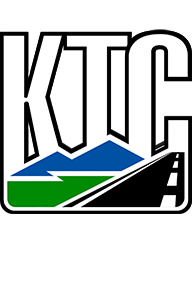Search for articles or browse our knowledge portal by topic.
Geotechnical Aspects of Highway Maintenance
Contents
2.1 Drainage
2.2 Erosion and Vegetation
2.3 Earthwork Activities
2.4 Patching Pavement
3.1 Cleaning Ditches and Benches
3.2 Scaling and Trimming
3.3 Drainage
3.4 Protection Measures
4.1 Bridges
4.2 Retaining Walls
4.3 Culverts and Pipes
A geotechnical investigation provides design, construction, and maintenance recommendations that, when implemented, reduce the risk of stability, safety, and life-cycle performance problems. When recommendations are not followed, highway assets are more likely to exhibit unsatisfactory performance. This may result in additional maintenance, repair, and replacement costs as well as indirect user costs. Failing to adequately maintain a highway asset can similarly increase the possibility of unsatisfactory performance. Multiple highway maintenance practices can help extend asset life, reduce future maintenance obligations, reduce life cycle costs, and correct existing problems.
Kentucky’s rolling to rugged terrain, combined with geological formations rich in clayey soils susceptible to moisture changes, increase the risk for landslides. Landslides can occur in both natural and constructed slopes such as embankments, fills, or cuts. Review the HKP article Landslides for more information on types of slope movements, their causes, visual indicators of movement, and corrective measures that can be taken to reduce the probability of landslides. Before performing maintenance operations in a known or potential landslide area, maintenance personnel should contact the Division of Structural Design Geotechnical Services Branch for advice and support in how these operations impact slope stability.
Maintenance activities can prevent, reduce, correct, or even accelerate landslides. As such, when landslide-related issues arise, maintenance operations should begin as soon as possible because delays can cause slides to worsen and grow, potentially rendering a facility inoperable. It is typically cheaper to address landslides early because as they grow and worsen repair costs increase. The following sections discuss maintenance activities and their importance to landslide activity.
2.1 Drainage
Water is the number one contributor to slope failures. As water infiltrates and saturates soil, the soil’s weight increases. This adds weight to a landslide and reduces soil strength. Several common maintenance activities can help prevent or reduce water infiltration into the soil.
2.1.1 Ditches and Cross Drains
When water pools in ditches due to improper grades, debris blocking a ditch, or because cross drains or culverts are clogged or damaged, it can infiltrate and saturate soil (Figure 1).
Because saturated soil is heavier than unsaturated soil, its presence increases landslide forces while reducing the soil’s strength to resist those forces. Ensuring ditches and cross drains function properly and do not contain standing water can prevent, mitigate, or correct landslide movement. Care must be taken when cleaning ditches not to over-excavate (see Section 2.3 on Earthwork Activities).
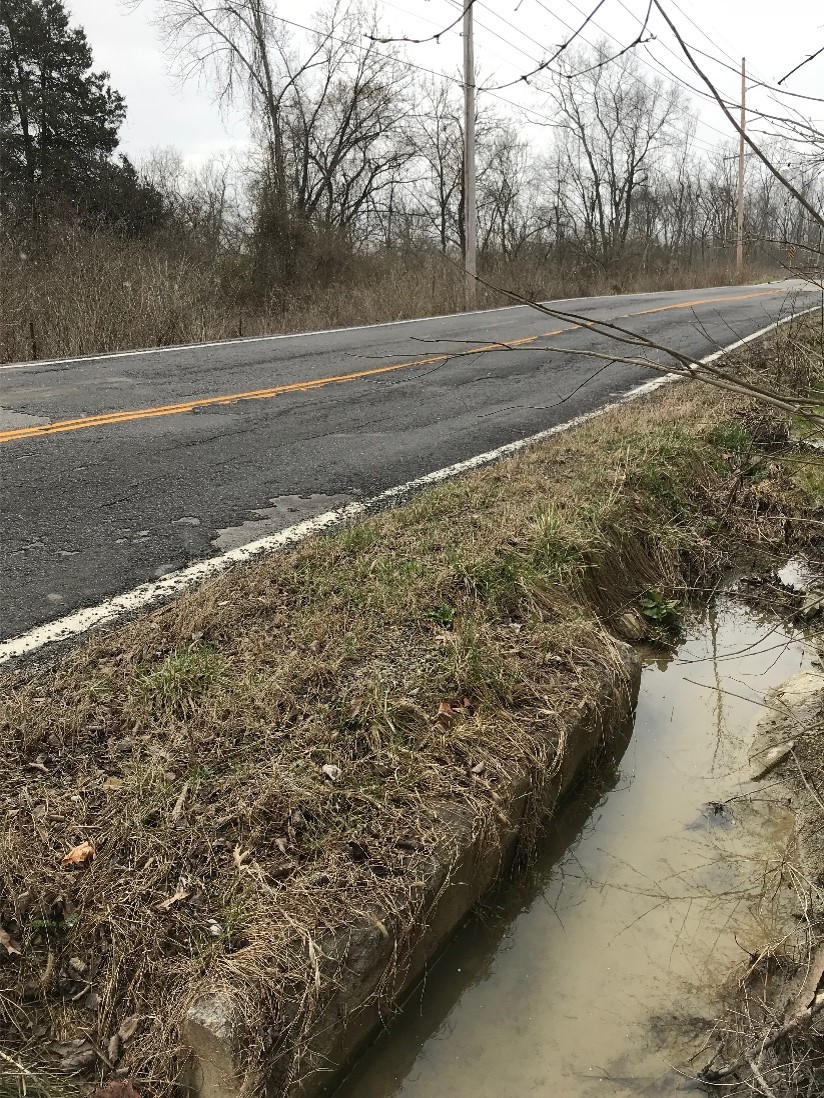
2.1.2 Surface Drainage
Control of surface drainage can reduce infiltration of water into soil. Ditches, downspouts, swales, ponds, sedimentation basins, pavement runoff, and other sources of water above a landslide can saturate soil and trigger or accelerate landslide movement. Diverting surface water away from a landslide can reduce the potential for mass movements and erosion.
2.1.3 Subsurface Drainage
Fluctuations in groundwater level due to precipitation, springs, standing water (e.g., ponds or lakes), or surface drainage infiltration can contribute to landslide movement. In some cases, correcting surface drainage issues can reduce water infiltration into a landslide. In other cases, dealing with subsurface drainage requires construction of subsurface drainage features such as French drains, horizontal drains, or spring boxes to intercept and remove groundwater from a landslide. Some of these solutions may be beyond the capabilities of maintenance forces. It is often beneficial to consult with the Division of Structural Design Geotechnical Services Branch on possible solutions when subsurface drainage is suspected of contributing to a landslide.
2.2 Erosion and Vegetation
Erosion and vegetation conditions can impact the potential for landslides. Erosion from surface or pavement drainage flowing over a slope removes soil material and vegetation that may be stabilizing a slope. Erosion along rivers and streams can also remove stabilizing soil material and initiate slope failures. As failures begin, erosion accelerates, which leads to larger and larger failure areas. Erosion can be mitigated through the placement of gabion baskets, rip rap, channel lining, controlling surface drainage, installing pavement wedge curbs and flumes to control pavement runoff, and reestablishing vegetation. In addition to mitigating erosion, vegetation draws water out of the soil, and plant roots create a mat that helps reinforce soil. Thus, establishing vegetation is also key to preventing failures and maintaining slope stability.
2.3 Earthwork Activities
Earthwork (fill placement or excavation) can impact slope stability. Excavation at the toe of a slope (e.g., cleaning ditches, excavation for building pads, making an existing slope steeper) removes stabilizing material that supports the weight of overlying soil. Placing fill at the top of a slope adds weight to a potential slide, increasing the probability of failure. When cleaning ditches, it is important to not over-excavate and destabilize slopes above the ditch. A ditch may be blocked because the slope above is failing, and removing material from the ditch will worsen the slide. Remove only enough material from a ditch to ensure that it does not hold water. Excavated material from ditch cleaning should not be cast over the other side of a roadway onto the upper portion of an embankment slope because it adds weight to a potential slide. To avoid adding weight to top of a slide, excavated material slated for wasting should be placed at the toe of a slope whenever possible, or the existing slope should be reworked to flatten it. See Section 4.1 of the HKP article Landslides (Slope Flattening, Berms, and Slope Height Reductions).
2.4 Patching Pavement
Cracks and movement in the pavement surface are typical indicators of landslide movement. Visual evidence of horizontal and vertical movement include drops or sags in guardrail, bent or non-vertical tree trunks, and tilted telephone poles. Maintenance forces often need to seal pavement cracks or patch pavement surfaces to keep roads safe for operation after mass movement events. However, asphalt patching material is heavier than soil and adds additional weight to the slide. Over time, as multiple patches are applied, several feet of asphalt patch can accumulate at a landslide location (Figure 2). This additional weight can accelerate and expand the area where mass movement is occurring. If frequent patching is needed, maintenance forces should seek assistance from the Division of Structural Design Geotechnical Services Branch staff to assess the site. These staff can propose other measures to slow down or correct landslide movement. If significant amounts of asphalt patch have been placed at a site, it may be prudent to remove the asphalt patch material and replace it with free-draining crushed stone, which is lighter than asphalt.
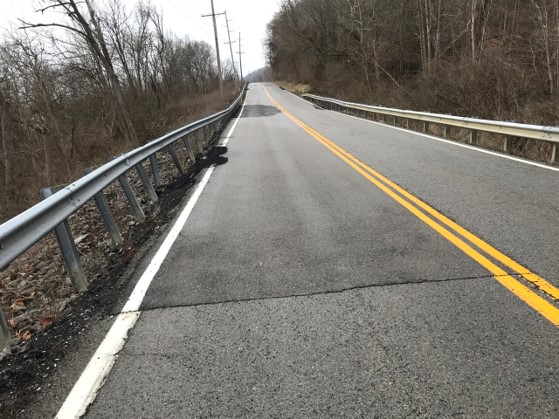
Figure 2: Pavement patches at landslide area. Note indicators of landslide movement in the number of patches, tilted trees, tilted utility poles, and guardrail movement.
Proper maintenance of rock slopes can reduce the potential for falls, topples, and slides, or prevent them entirely. Factors which contribute to rock slope movement include:
- Water — As with landslides, water saturates the rock mass, adding to the mass’s weight and reducing its ability to resist movement. Freezing water can widen joints and cracks, increasing the potential for rock slope movement.
-
Differential Weathering — Some bedrock formations weather faster than others (e.g., shales), and can undercut layers of more resistant bedrock (Figure 3).
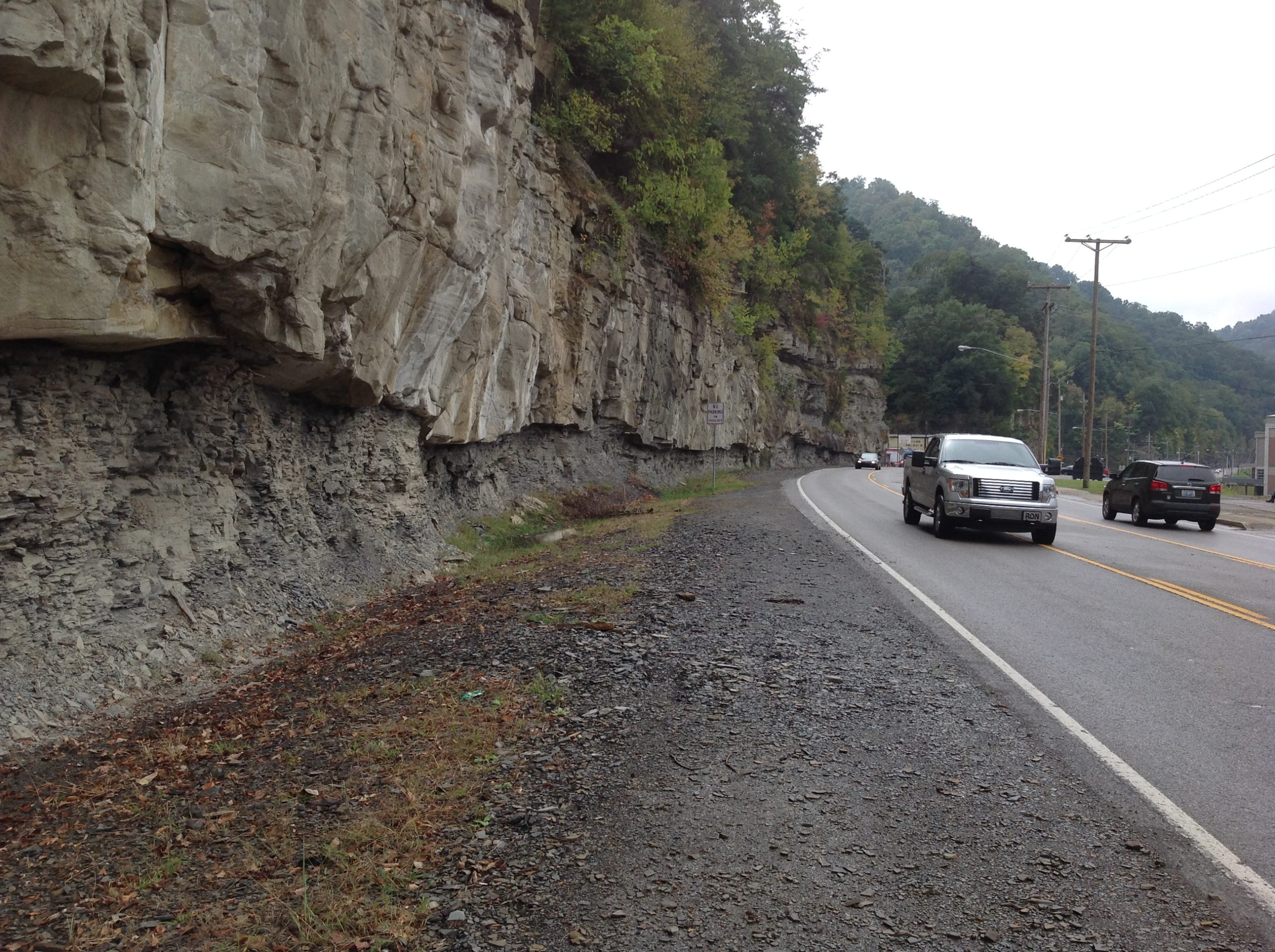
Figure 3: Differential weathering of a softer shale beneath a more resistant sandstone layer.
- Joints — Naturally occurring joints in bedrock can lead to topples or slides of blocks of bedrock.
- Bedding Planes — Bedding planes (i.e., where different bedrock formations meet) can be sliding planes, particularly where more resistant bedrock overlies a weaker layer.
- Karst — Karst features leave irregular and weakened bedrock surfaces that are prone to instability.
- Human Activity — Human activities such as excavation, mining, blasting, and water diversion can lead to rock slope instability.
To determine appropriate maintenance or corrective actions, it is critical to closely monitor rock slope movements. Monitoring can be performed visually, with instrumentation, or using remote sensing methods such as satellites or drones. In some cases, it may be necessary to contact the Division of Structural Design Geotechnical Services Branch for assistance in evaluating rock slope conditions and possible corrective measures. For more information, refer to the HKP article Rock Slopes and Rockfalls.
3.1 Cleaning Ditches and Benches
Over time fallen rock can build up in ditches and on benches in the rock slope (Figure 4). This accumulated material functions as ramps that cast rockfalls onto the pavement. Cleaning out built-up rockfall material helps ditches and benches maintain their ability to catch and control rockfalls.
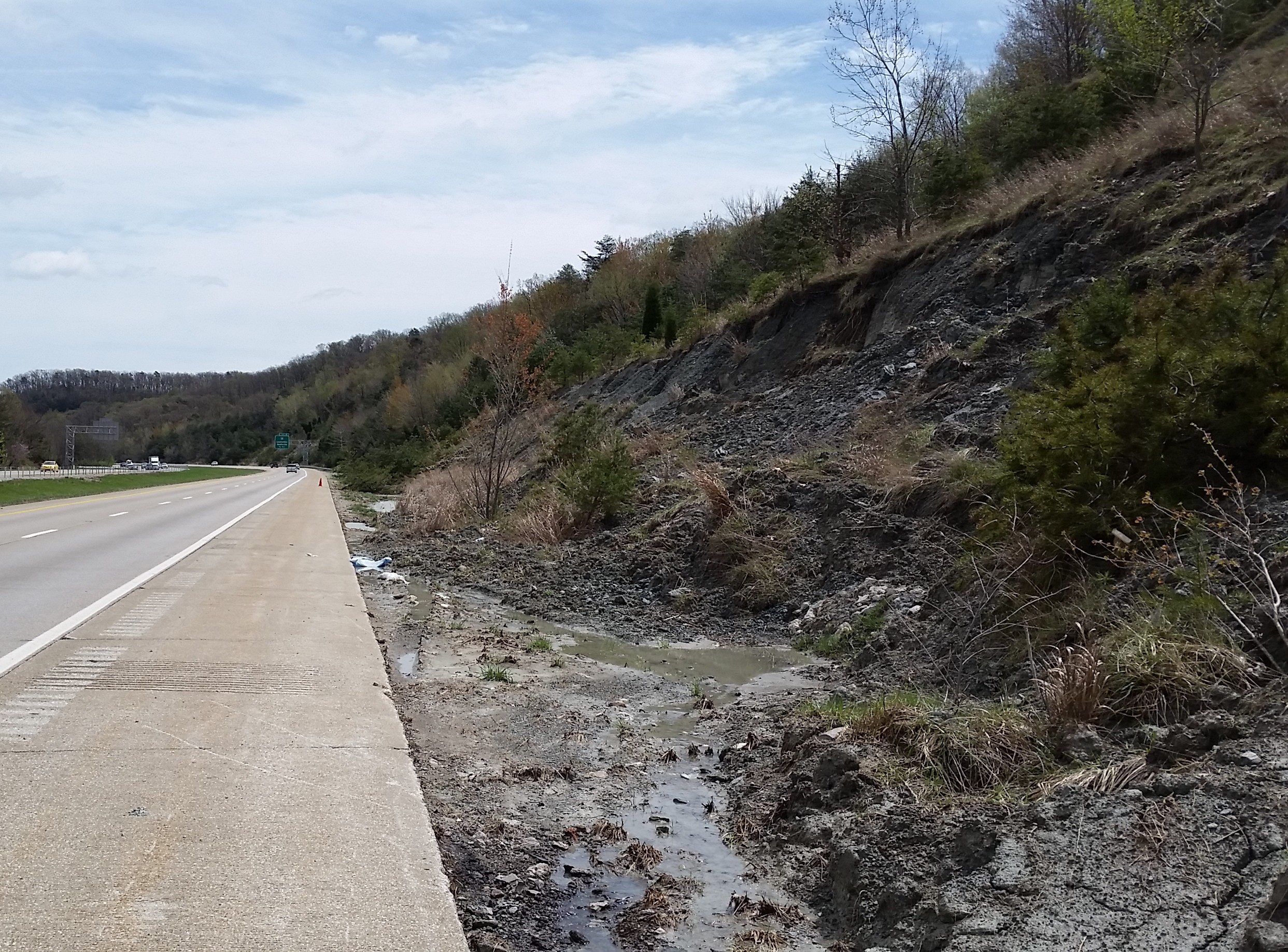
Figure 4: Fallen and slumped material from a rock cut blocking ditch drainage.
3.2 Scaling and Trimming
Loose, overhanging, or protruding rocks on the face of a rock slope can dislodge and fall or alter the trajectories of falling rocks. Scaling and trimming removes this material and can reduce or prevent falling rock from reaching a roadway. Scaling and trimming is typically done by hand using scaling bars, small excavation equipment, or light explosives. Trained maintenance personnel can perform light scaling, but KYTC typically retains specialty contractors when rock slopes present more complex issues.
3.3 Drainage
Like landslides, water contributes to rock slope instability. Proper surface and subsurface drainage can slow the deterioration of rock slopes. Keeping ditches clean and directing surface drainage away from a rock slope can keep water out of bedrock joints and reduces erosion of bedrock formations that are highly erodible.
3.4 Protection Measures
It can be cost-effective to let rock falls occur and control their distance and direction of travel. Protection measures should be used when rock falls are allowed to occur. These include:
- Catch Ditches — A ditch of specified depth and width is installed to catch falling rock. Ditches must be kept clean to operate properly.
- Draped Mesh — Mesh consisting of chain-link fencing is installed on a rock slope to control falling rock. Periodic maintenance is needed to ensure the mesh is in good condition as well as to clean out fallen material.
- Catch Fences and Attenuators — Fences and attenuators are used to contain high-energy rockfalls. These require designs tailored to site-specific slope conditions. Periodic maintenance is needed to ensure they remain in good operating condition. Occasionally replacement of portions of fences or attenuators is needed after a rockfall. Fallen material contained by the fence or attenuator must also be cleaned out occasionally to prevent build-up of material that can impact performance of the fence or attenuator.
- Barriers – Barriers can be used to contain rockfalls. These are often used in situations where space limitations prevent the use of a normal catch ditch. Barriers can be Jersey barriers (Figure 5), large concrete blocks, soil berms, or even shipping containers. The area behind barriers must occasionally be cleaned of rock fall material to maintain their effectiveness.
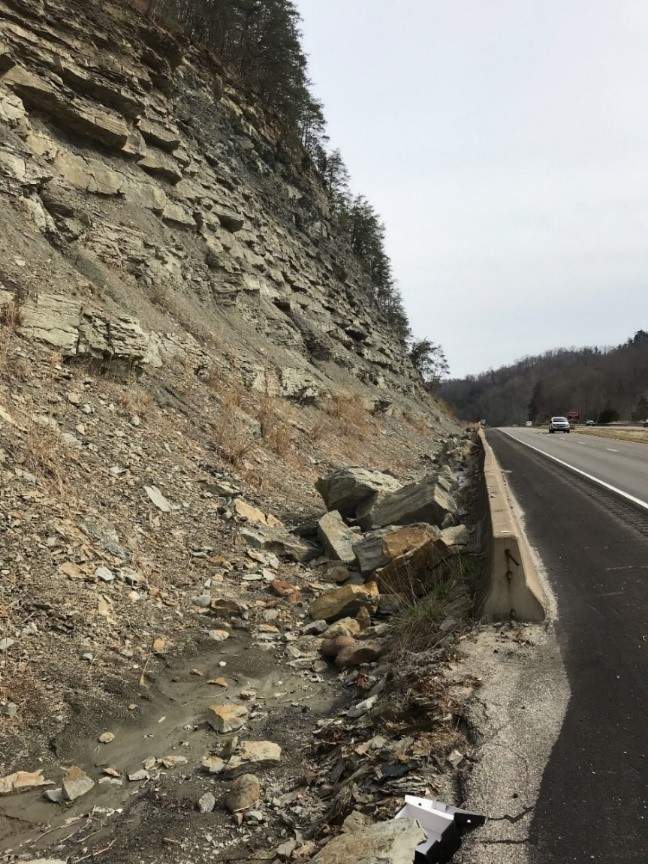
Figure 5: Jersey barriers used to catch fallen rock.
Design of protection measures often need to be site-specific. Contact the Division of Structural Design Geotechnical Services Branch for assistance with determining proper measure to install.
Geotechnical-related problems at structures such as bridges, walls, or culverts, can be reduced or prevented with simple and routine maintenance activities. Many of these maintenance activities attempt to control drainage and its associated impacts.
4.1 Bridges
Bridge health can be negatively affected by geotechnical and drainage problems like landslides, excessive settlement, unequal soil pressures, scour, and erosion. Visual signs of these problems are described below.
4.1.1 Bump at the End of the Bridge
Excessive settlement of bridge approaches manifests in large bumps between the bridge and the approach pavement or in the need to frequently patch the approach to mitigate the bump. Settlement can be caused by one or more of the following:
- Settlement of foundation soils
- Improper compaction of approach embankment materials
- Runoff from the bridge surface saturating or eroding embankment soils at the bridge ends
When excessive settlement occurs, it can result in the following:
- Substructure movement or tilting
- Excessive deflection of bearings
- Excessive opening or closing of bridge joints
- Cracking of abutment or end bent back walls
- Additional loads on substructure and superstructure members
- Excessive axial and lateral loads on piles
- Exposed piles below the caps
- Embankment failures
- Erosion of embankment soils
- Failure of bridge end drainage where drainage cannot reach the drop boxes, pipes pull apart, or both (Figure 6)
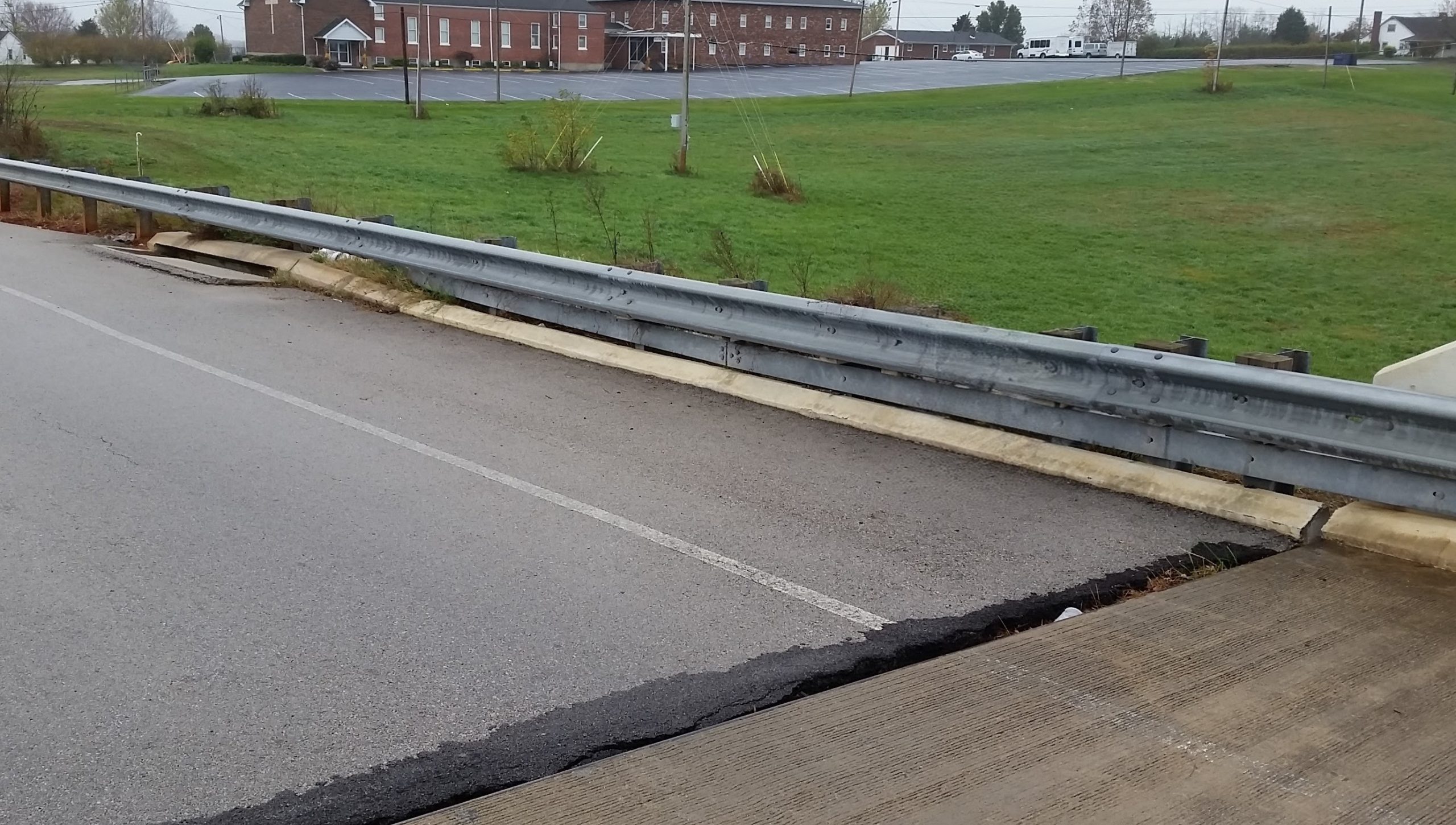
Figure 6: Drainage problems at end of bridge with integral end bent. Note separation between pavement and bridge end allowing surface drainage to flow behind end bent wall. Also note settlement that prevents drainage from entering drop box.
Settlement at bridge ends is difficult to repair after construction is complete, but some maintenance activities can help mitigate its impact:
- Wedge the approach pavement as needed. This helps reduce the bump as well as any impact loads to the bridge from traffic. It can also help surface runoff get to the bridge end drainage instead of infiltrating embankment soils. Keep in mind that asphalt is heavier than soil and may accelerate settlement somewhat. In severe settlement cases, it may be necessary to remove and replace a portion of the backfill material behind the abutment or end bent.
- Maintain deck and bridge end drains so surface runoff does not saturate embankment soil or erode embankment slopes.
- Contact the Division of Structural Design Geotechnical Services Branch for assistance. Staff can evaluate the site and, in some cases, recommend maintenance actions that can minimize or repair the problem.
4.1.2 Erosion and Scour
Erosion and scour are closely related issues that can result in maintenance issues and potentially bridge failure. Erosion is the removal and transport of earthen materials by water, wind, or ice. Scour is the erosion of soil or rock— typically by water — surrounding bridge footings, piers, or abutments. Scour can result in loss of foundation support and thus bridge substructure movement or failure. Bridge inspections identify when scour is undermining a bridge foundation, while maintenance personnel can help identify erosion and scour issues between inspection cycles. Countermeasures can be installed to mitigate or prevent erosion and scour, but countermeasures should be carefully designed and installed to ensure proper performance. Activities maintenance personnel can undertake to address erosion and scour include:
- Checking bridge deck drains, bridge end drainage, and pavement runoff to ensure they are not creating erosion issues. If erosion occurs at these features, use channel lining, rip rap, paved ditches/flumes to control runoff and prevent further erosion. If deck drains or bridge end drainage pipes are blocked or pulled apart, clean and repair them as needed. Pipe outlets should not be located on mid-embankment slopes as they can create erosion paths.
- Maintaining slope protection (e.g., rip rap, channel lining, slope paving) on bridge approach embankment slopes. If it appears slope protection is not working (i.e., eroded or missing), notify District Drainage and Bridge Maintenance personnel to determine an appropriate repair.
- Document scour that occurs at bridge foundations and approach embankments. Notify District Drainage and Bridge Maintenance personnel to determine an appropriate repair.
- Removing debris buildup around bridge piers. Debris buildup (e.g., trees, brush, trash) blocks water flow through a bridge and worsen scour. This scour can exceed what the bridge foundation was designed to accommodate.
4.1.3 Movement of Bridge Substructures
Excessive movement of bridge substructures beyond what is attributable to thermal changes can be a sign of geotechnical problems such as landslides, excessive settlement, scour, erosion, or excess earth pressure loads. If excessive movement of a bridge substructure is suspected, maintenance personnel should notify their District Bridge Engineer. Signs of excessive movement include:
- Deflection of bridge bearings in excess of what is caused by thermal changes (Figure 7)
- Beams in contact with or a reduced gap between the beams and the backwall of a non-integral abutment or end bent
- Beams not in contact with the bearings
- Closed, excessively open, or twisted bridge joints
- Tilted piers, abutments, or end bents
- Detached or broken wingwalls
- Exposed piles
- Cracking of abutment or end bent back walls
- Cracking of approach slabs
- Excessive settlement, gaps, and pavement issues behind integral abutments or end bents
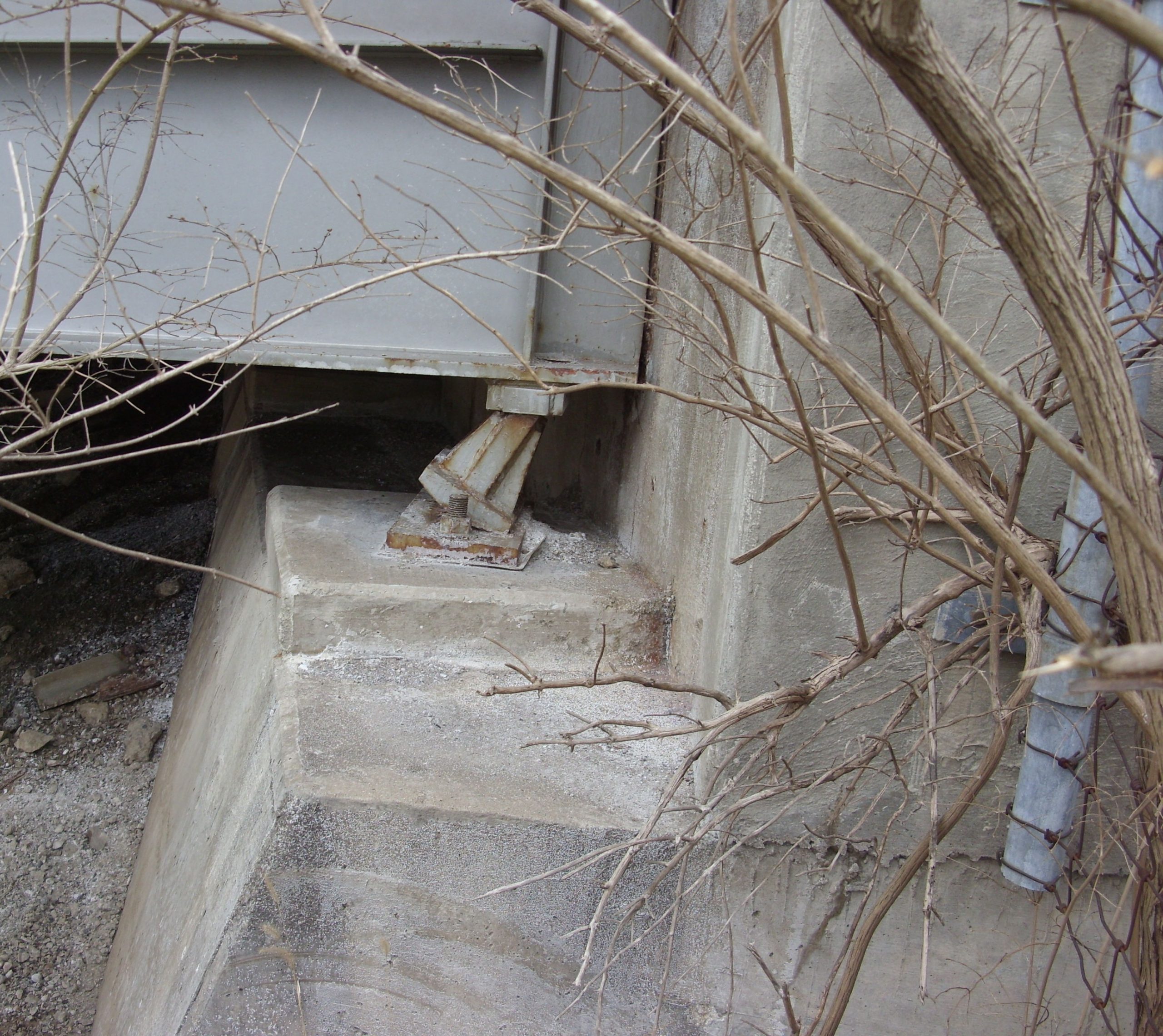
Figure 7: Excessive deflection of rocker bearing due to approach embankment movement.
4.2 Retaining Walls
Retaining walls are used to minimize right-of-way needs and prevent impacts to nearby resources such as streams, buildings, environmentally sensitive areas, and parks. Walls often directly support roadway pavements and bridge structures. Signs of distress in retaining walls include tilting, cracking, differential settlement, and horizontal movement. Since retaining walls do not undergo required inspections like bridge structures, maintenance forces are often the first and maybe only personnel to note potential retaining wall problems. Activities that maintenance personnel can undertake to prevent problems with retaining walls are similar to those that can be undertaken for bridges:
- Ensure surface and storm drainage is controlled and directed away from the retaining wall. Water may saturate the soil behind the wall, which adds additional earth pressure to the wall.
- Check for and repair erosion and scour that occur, particularly at the toe of the wall.
- Check to verify that weep holes in the wall are clean and functioning.
- Inspect for loss of material behind and through the wall’s face (i.e., soil material flowing or raveling between cracks or gaps in the wall face).
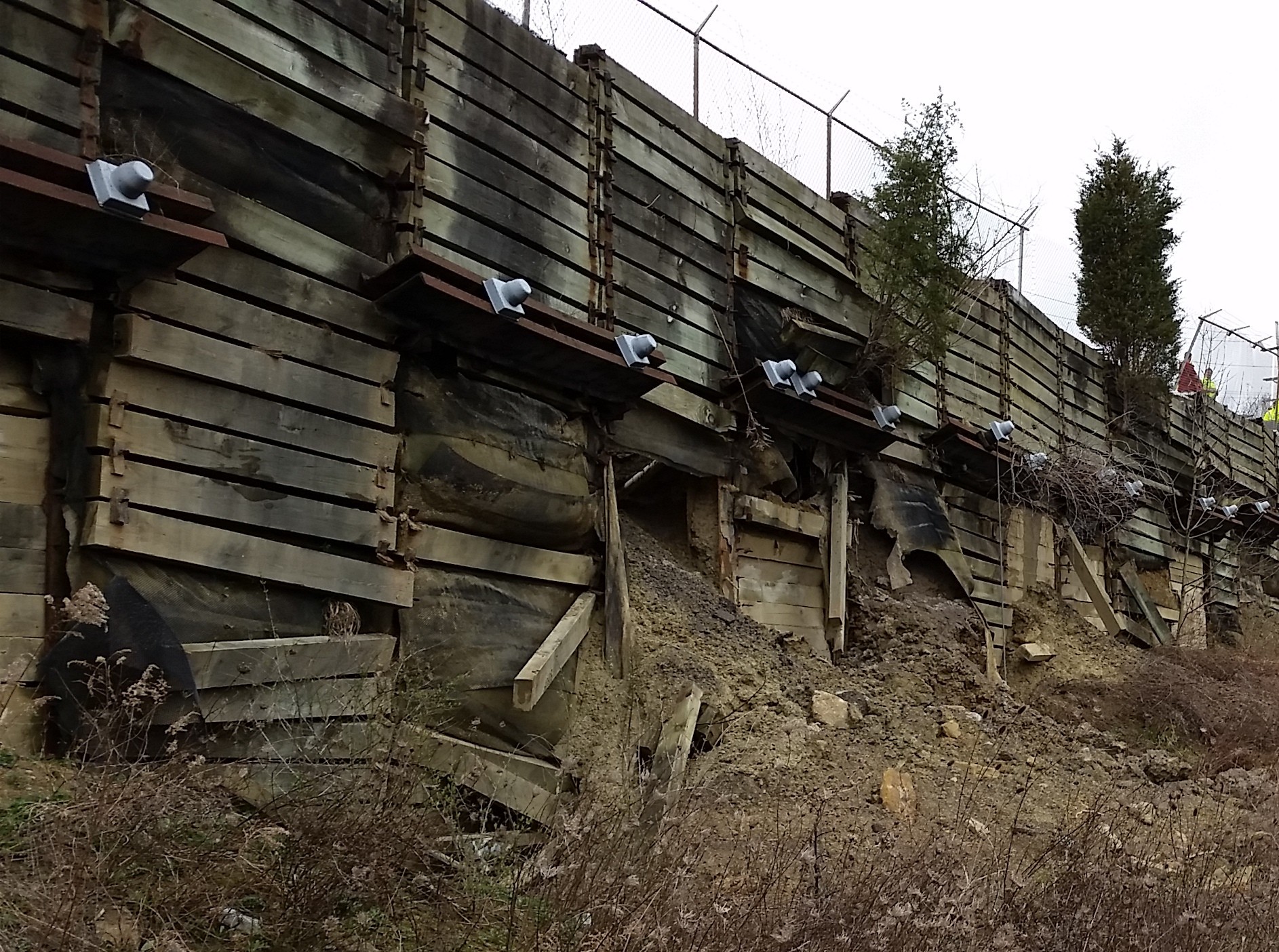
Figure 8: Loss of material behind a tieback wall due to corrosion of steel brackets allowing wood lagging to fail. Also note vegetation (cedar trees) growing from between wood lagging.
- Remove woody and brushy vegetation from the wall face and for a distance behind the wall approximately equal to the wall height. Plant roots can exert additional pressures on the wall and/or cause cracking of the wall facing.
- Note when land use changes in the vicinity of the wall. Permanent structures, stockpiles, site grading, or other human activities behind a wall can add additional forces on the wall and can modify drainage patterns. If these were not accounted for in the wall design, it could add additional pressure on the wall and result in unexpected movement or distress.
4.3 Culverts and Pipes
Culvert and pipe maintenance plays a key role in preventing geotechnical-related issues with roadways and structures. Culverts and pipes that function poorly can cause water to pool in ditches, and that standing water can result in failures of slopes, pavements, and walls. If problems with culverts or pipes occur, maintenance personnel should contact District staff to determine a plan of action. Signs of problems with culverts and pipes include:
- Settlement of pavement above a culvert or pipe — Settlement can indicate that backfilling around the culvert or pipe was done incorrectly. It can also mean that the culvert or pipe separated, and soil material is lost through the gap. When large settlements occur the culvert or pipe may separate or crack. Large settlement may also impact water’s ability to pass through a culvert or pipe. If excessive settlement is observed, check the culvert or pipe for separation and verify that drainage can pass through the conduit as intended.
- Separation of culvert or pipe — Culverts and pipes can separate due to landslide movements, excessive settlement, improper construction, or deterioration/corrosion (Figure 9). Separation impairs culvert and pipe drainage functions. Water can also enter soil through separation, potentially triggering landslides, failure of headwalls, and erosion. If separation occurs, the culvert or pipe may need to be replaced, retrofitted with a liner, or repaired in place.
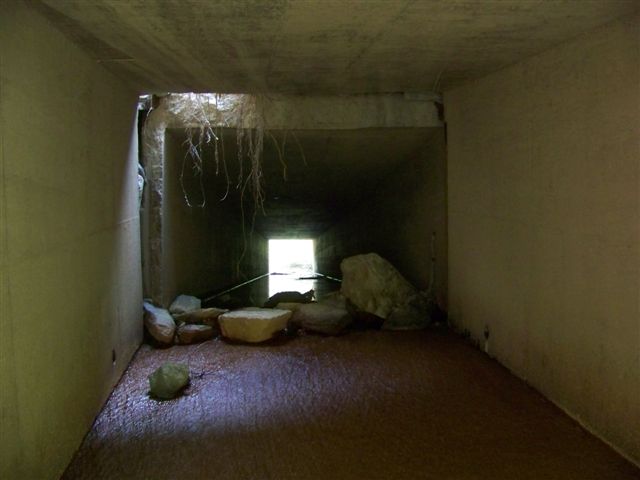
Figure 9: Separation of culvert barrel allows embankment material to ravel into culvert.
- Erosion or scour at inlets and outlets — Erosion and scour at inlets and outlets may prevent water from entering a culvert or pipe and result in standing water that can saturate the surrounding soil. Erosion and scour can also undermine headwalls, leading to failure, cracking, and settlement of the structure. Scour holes should be filled with appropriately sized channel lining or rip rap to prevent further erosion. In some cases, it may be necessary to pave inlet and outlet ends to prevent erosion and undercutting of the headwalls.
- Headwall movement and cracking — Headwalls can separate, crack, and settle due to factors such as excessive soil pressures, saturated backfill soils, slope failures, erosion, and scour (Figure 10). This can trigger slope movements above and around a headwall, settlement of the drainage structure, scour or erosion, impairing the structure’s ability to drain properly.
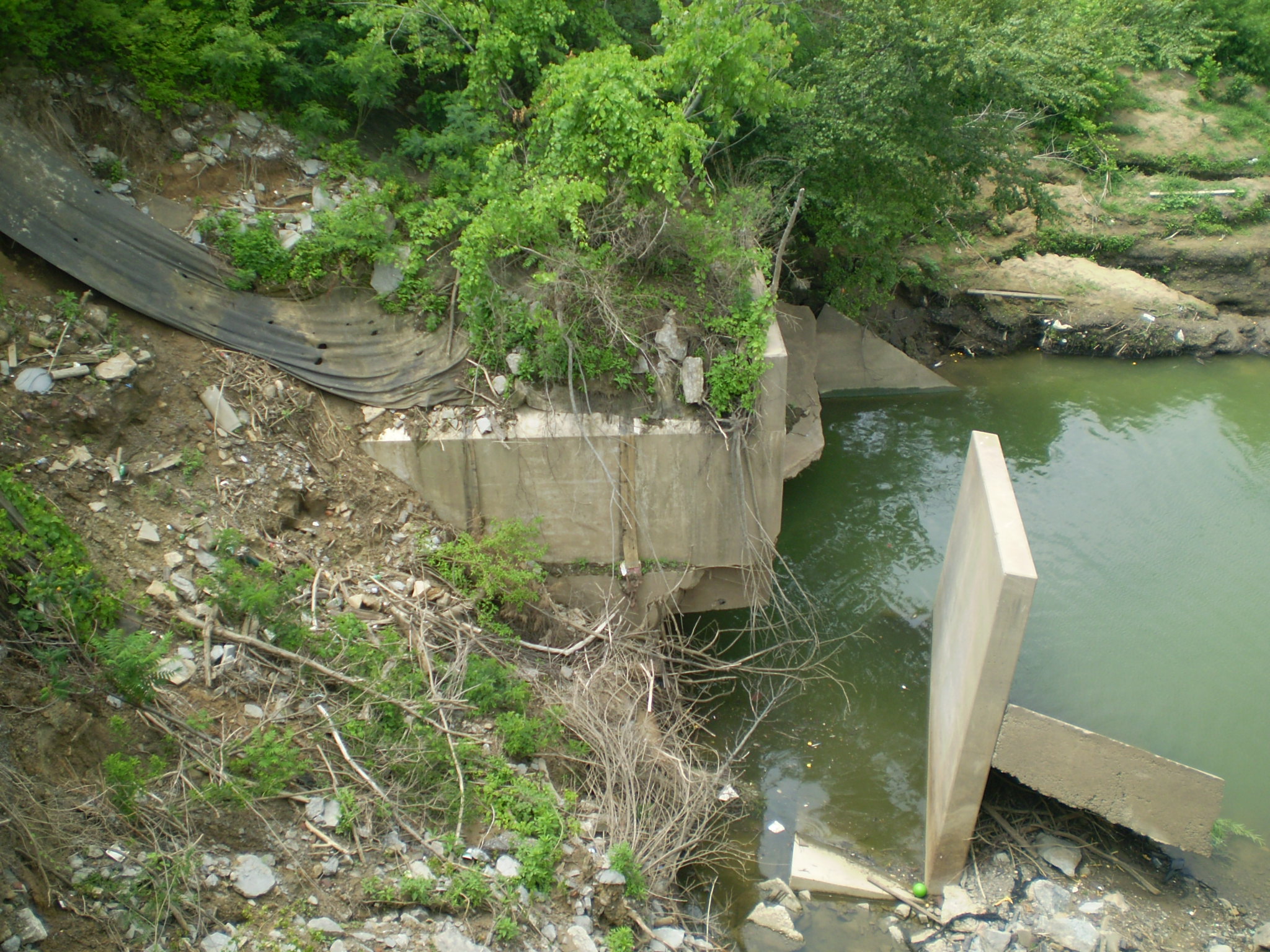
Figure 10: Failure of culvert wingwall due to scour at outlet and erosion of backfill soils.
Pavement problems related to geotechnical issues include rutting, base failures, and potholes. In almost all cases these problems stem from water within pavement structures or failure to control pavement surface drainage. Water within dense grade aggregate (DGA) or granular bases can also saturate subgrade soils, causing them to weaken. In some cases, local soil used for subgrade are poor quality and susceptible to failure when saturated, heavily loaded, or both. Using improper materials and poor construction techniques also increases pavement susceptibility to water-related problems. Water within the pavement structure can freeze, which leads to heaving and potholes. If the subgrade or base material is saturated with heavy wheels loads passing over the area, the loads can cause fines to “pump” out of the subgrade soil or base material, which eventually creates voids under the pavement. Maintenance activities used to prevent or remediate geotechnical related pavement issues include:
- Maintaining proper drainage in ditches, pipes, and culverts — Standing water in ditches can saturate the pavement subgrade and bases. Keeping ditches, pipes, and culverts free of debris helps water drain properly so it does not pool in ditches.
- Checking for erosion at pavement edges — Surface runoff from pavements can cause erosion at pavement edges and embankment slopes. This erosion can eventually undermine the pavement surface and guardrail (if present). Methods for controlling erosion include laying down crushed stone, reestablishing vegetation, and installing pavement edge curbs and flumes to prevent flow of surface drainage from the pavement onto embankment slopes.
- Maintaining pavement edge drains. Pavement edge drains drain water out of the pavement base and subgrade. Their outlets can become blocked with debris (e.g., trash, soil, vegetation, mower cuttings) and should be cleaned if needed. Rodent screens should be placed on outlets to prevent animals from entering, nesting, and blocking pipes.
Multiple geohazards impact highway and bridge maintenance. Refer to the HKP article Kentucky Geohazards and Their Impacts to Highways and Bridges for more. Geohazards include:
- Karst features such as sinkholes, springs, sinking streams, and caves (Figure 11)
- Earthquakes
- Faults and dipping bedrock
- Black shale and possible acidic runoff
- Mining and fuel extraction
- Stream migration
- Flooding
While some typical maintenance activities may be able to deal with less severe geohazard situations, it is often difficult to determine the extent of an issue and identify an appropriate fix. Maintenance personnel should contact the Division of Structural Design Geotechnical Services Branch when geohazards are encountered for advice on the extent of the issue and how best to remediate the problem.
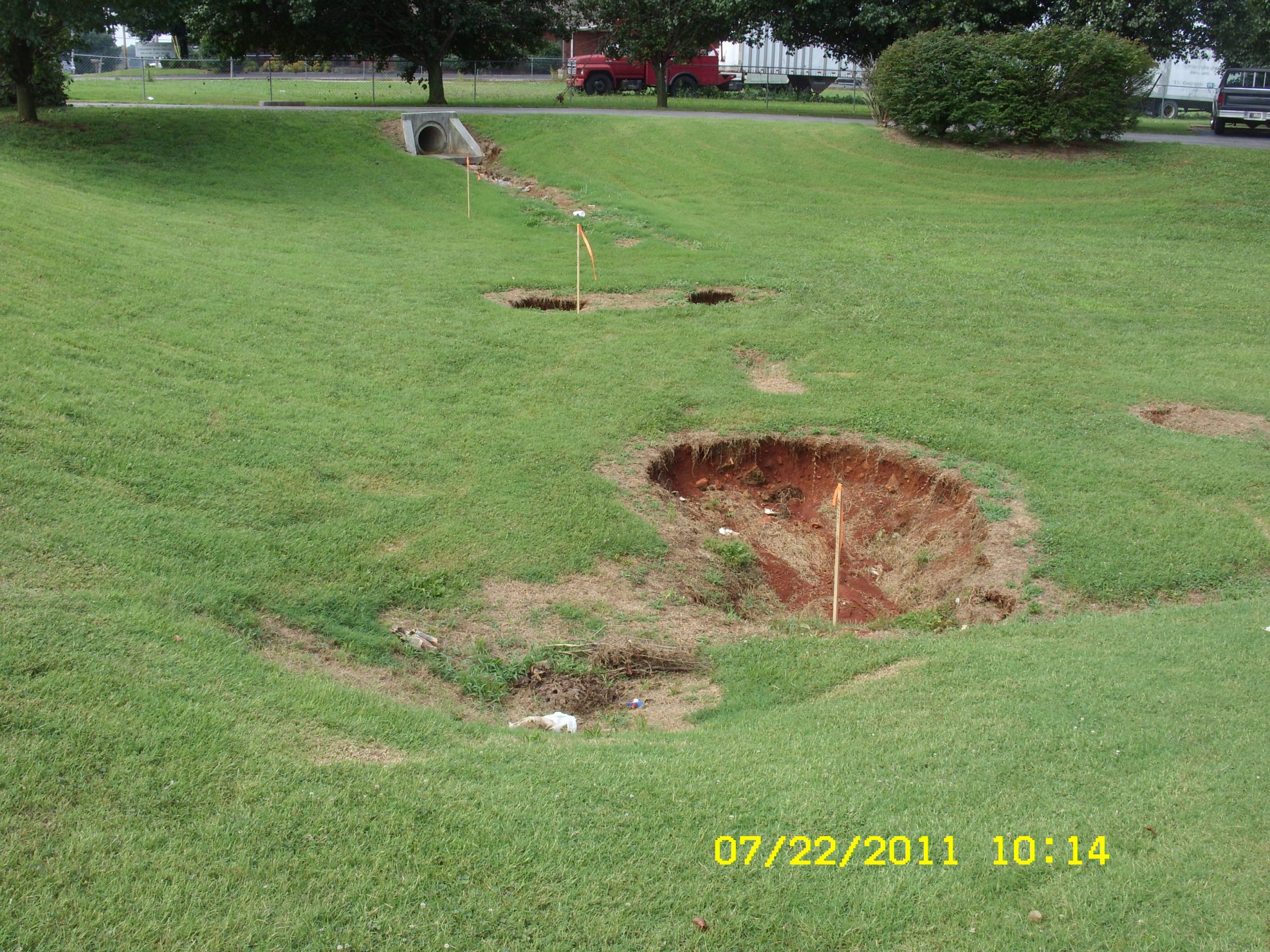
Figure 11: Sinkhole openings in the bottom of a stormwater detention basin.
When geotechnical problems arise during operation of a roadway or structure, it is often helpful to contact the Division of Structural Design Geotechnical Services Branch Manager for assistance. Requests are passed on to the appropriate staff in the Geotechnical Branches. Advice from Geotechnical Branches can help maintenance forces efficiently utilize their resources when addressing an issue.
Assistance can range from a single site visit to a full investigation with drilling, sampling, lab testing, and instrumentation. When needed, a maintenance investigation by the Geotechnical Services Branch will include plans, recommendations, notes, or other items needed to help maintenance forces correct the problem. Refer to the HKP article Geotechnical Investigations – Where to Begin and How to Proceed for additional information on initiating a maintenance investigation.
Geotechnical Topics Knowledge Book:
Access the complete Knowledge Book here: Geotechnical Topics Knowledge Book
Previous Article: Geotechnical Aspects of Construction

